The literature of Myanmar spans over a millennium. The Burmese language, unlike other Southeast Asian languages, adopted words primarily from Pāli rather than from Sanskrit. In addition, Burmese literature tends to reflect local folklore and culture.

King Thibaw, also Thebaw or Theebaw, was the last king of the Konbaung dynasty of Burma (Myanmar) and also the last Burmese monarch in the country's history. His reign ended when the Royal Burmese armed forces were defeated by the forces of the British Empire in the Third Anglo-Burmese War, on 29 November 1885, prior to its official annexation on 1 January 1886.
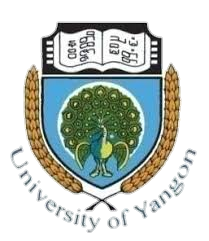
The University of Yangon, located in Kamayut, Yangon, is the oldest university in Myanmar's modern education system and the best known university in Myanmar. The university offers mainly undergraduate and postgraduate degrees programs in liberal arts, sciences and law. Full-time bachelor's degrees were not offered at the university's main campus after the student protests of 1996. The bachelor's degree was re-offered from 2014 on. Today degrees in Political Science are offered to undergraduate students, as well as postgraduate diplomas in areas such as social work and geology.
Sir Maung Khin KCIE was the first Burmese judge of the Chief Court of Lower Burma during the British colonial era, and the first Burmese to be knighted. Maung Khin was known as a good, clean administrator, widely respected by the public.
The cinema of Burma has a long history dating back to the 1910s. The person who created the first silent film was Ohn Maung.
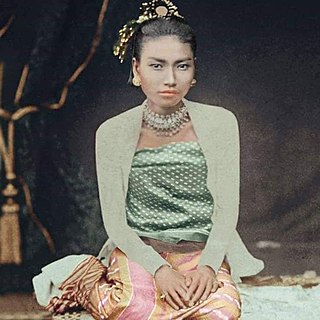
Supayalat, also spelt Suphayalat, was the last queen of Burma who reigned in Mandalay (1878–1885), born to King Mindon Min and Queen of Alenandaw. The British corruption of her name was "Soup Plate". She was married to her half-brother, Thibaw, who became the last king of the Konbaung dynasty in 1878, upon Mindon Min's death. She is best known for engineering a massacre of 80 to 100 royal family members, to prevent potential rivals from usurping Thibaw's power, although she had always denied any knowledge of the plot, which may have been hatched by her mother together with some of the ministers, including the chancellor Kinwon Min Gyi U Kaung.

Thakin Kodaw Hmaing is considered one of the greatest Burmese poets, writers and political leaders in the 20th century history of Burma. He is regarded as the Father of Burmese nationalist and peace movements as well as a literary genius. His legacy and influence on the post-war generations can still be felt in both literature and the ongoing political situation in Myanmar (Burma).

A1 Tin Maung was a two-time Burmese Academy Award-winning film actor, director and producer.

Htin Aung was a writer and scholar of Burmese culture and history. Educated at Oxford and Cambridge, Htin Aung wrote several books on Burmese history and culture in both Burmese and English. His English-language works brought a much-needed Burmese perspective to the international study of Burmese history, previously written by British historians of the colonial era. His important works include A History of Burma, Folk Elements in Burmese Buddhism, Selections from Burmese Folk Tales, Thirty Burmese Tales and Burmese Drama.
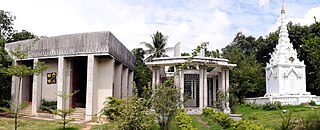
The Kandawmin Garden Mausolea comprise a mausoleum complex in Yangon, Myanmar. The site contains four mausolea of Burmese national figures and is located near the southern gate of Shwedagon Pagoda. The successive Burmese military governments feared that the mausolea might become a meeting place for democracy activists and they fell into a state of neglect. The former military regime omitted them from the Yangon City Heritage List because they are symbols of national liberty and considered a threat to its status and power.

Princess Hteik Su Phaya Gyi, also known as Su Su Khin or Pwar May or Princess Tessie, was a Burmese princess and the final surviving royal of the Konbaung dynasty. Daughter of Princess Myat Phaya Galay, she was a senior member of the Royal House of Konbaung.
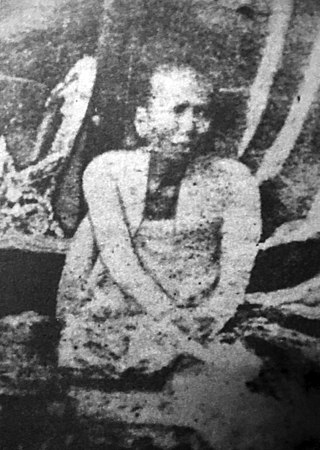
Hsinbyumashin was a senior queen of King Mindon Min during the Konbaung dynasty. She was known for Bronze Hall Massacre. She was the daughter of King Bagyidaw and his consort Nanmadaw Me Nu (Chief Queen of King Bagyidaw). She was one of the most influential queen consorts in Burmese history, and often regarded as the power behind the throne.
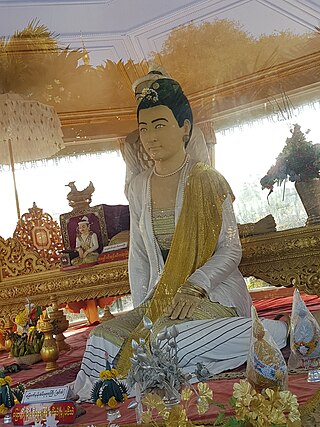
Khin The, commonly known by her regnal title Thiri Maha Yadana Mingala Dewi, was the Queen of the Northern Palace of King Mindon Min during the Konbaung dynasty. Among several queen consorts, Khin The was the favored queen of King Mindon.

Daing Khin Khin, also known as Mi Khingyi, was a Burmese noblewoman and royal concubine of Thibaw Min, the last monarch of the Konbaung dynasty. She became the central figure in a renowned Burmese historical account that narrates a queen's endeavors to ensure fidelity in a reigning monarch.

Khin Maung Yin was a Burmese actor and singer. He is best known for starring in film Bo Aung Din (1941) as the character Bo Aung Din.
Taungthaman Le-sarMaung Pe Nge, was a Burmese court official, noted poet, and a companion of King Thibaw. He was the Lord of Taungthaman with the title of Taungthaman Le-sar (တောင်သမန်လယ်စား).

Mary Myint was a Burmese film actress, theatre actress, singer and writer. She acted as leading actress in 47 Burmese films. She was famous around the 1950s.
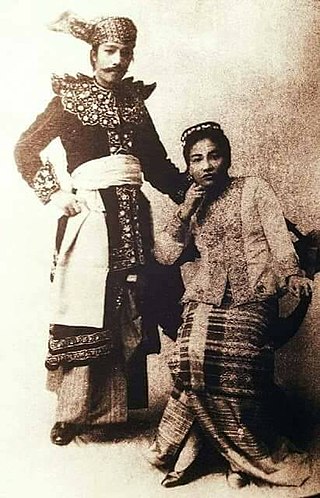
Khin Maung Lat, also known as Lat Thakin, was a Burmese nobleman and courtier. He had served as Royal Secretary to King Thibaw from 1914 to 1916. He married Princess Myat Phaya Lat, the second daughter of King Thibaw and Queen Supayalat.

Taingda Mingyi U Pho was a Burmese official of the royal courts of King Mindon and King Thibaw during the Konbaung dynasty. He became the most powerful official at King Thibaw's court and held several key positions, including Minister of the Interior, Minister of Defense, and Senior Minister of the Hluttaw. Taingda was seen as an opponent of Kinwun Mingyi U Kaung and the leader of the conservative faction that advocated for war with the British.














